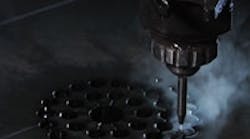The experts call waterjet cutting the fastest growing major machine tool segment in the world. The reason? "With the advent of abrasive waterjet methods, the technology has quickly evolved to efficiently and accurately cut virtually any material," says Mohamed Hashish, senior vice president of technology at Flow International Corp. The fastest growing sectors are as diverse as aerospace, job shops, electronics and the stone and tile industry. "Abrasives are not used in all waterjet applications," Hashish notes. Among the exceptions are applications such as surface preparation, cleaning, food cutting and paint removal.
"Job shops and the rest of contract manufacturing are today's largest markets for waterjet cutting," adds Michael Ruppenthal, Flow International's vice president of marketing and product management. In second and third place are stone cutting and aerospace applications.
"Those buyers are seeking the business/process advantages of versatility and flexibility in their operations," Ruppenthal says. "The unique attribute of a waterjet machine is its ability to cut anything. If you're a machine shop, waterjet versatility is important because it is difficult to predict the exact nature of the next job."
Other waterjet attributes include lessened fixturing requirements, the ability to cut without heating and distorting the workpiece, plus the ability to cut with a narrow kerf. In addition, waterjets can also be a more cost-effective alternative because jobs that may normally take several hours to complete can often be cut in just minutes.
Ruppenthal sees waterjet cutting becoming the preferred method for cutting and trimming composites because no heat is generated and no delamination occurs. Delamination is prevented, explains Hashish, because the abrasive waterjet acts as a nano-machining process. "The actual cutting occurs on a micro level without destructive heat generation. Conventional machining of composites can run into problems because multiple laminated layers are attacked simultaneously."
Operating Principle
Behind Waterjet Cutting
Ruppenthal increasingly sees waterjet cutting teamed with conventional machining centers. "The idea is to leverage waterjet's ability to cut without heat or stress creation. "What we're seeing is machine shops increasingly using waterjets for rough cutting or hogging out and then reaching the net shape on a conventional machining center. The result: faster production of the desired part plus reusable chunks of metal that are more economically desirable than just a big pile of chips. In some cases the waterjet equipment can produce the net shape as well, depending on the required tolerances and surface finish."
"The moral," says Hashish, "is that the more designers and engineers know about waterjet attributes, the more they'll design for the advantages." Adds Ruppenthal: "Waterjet cutting is an awareness game of educating people to think differently to take advantage of its unique characteristics."
See Also



